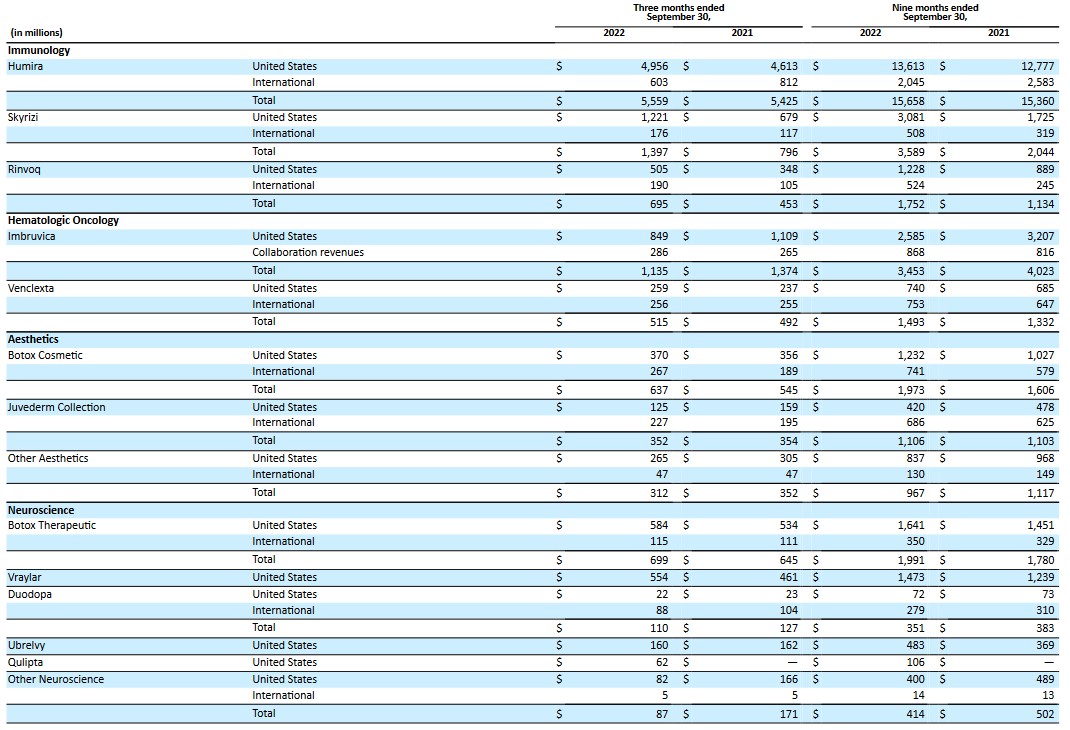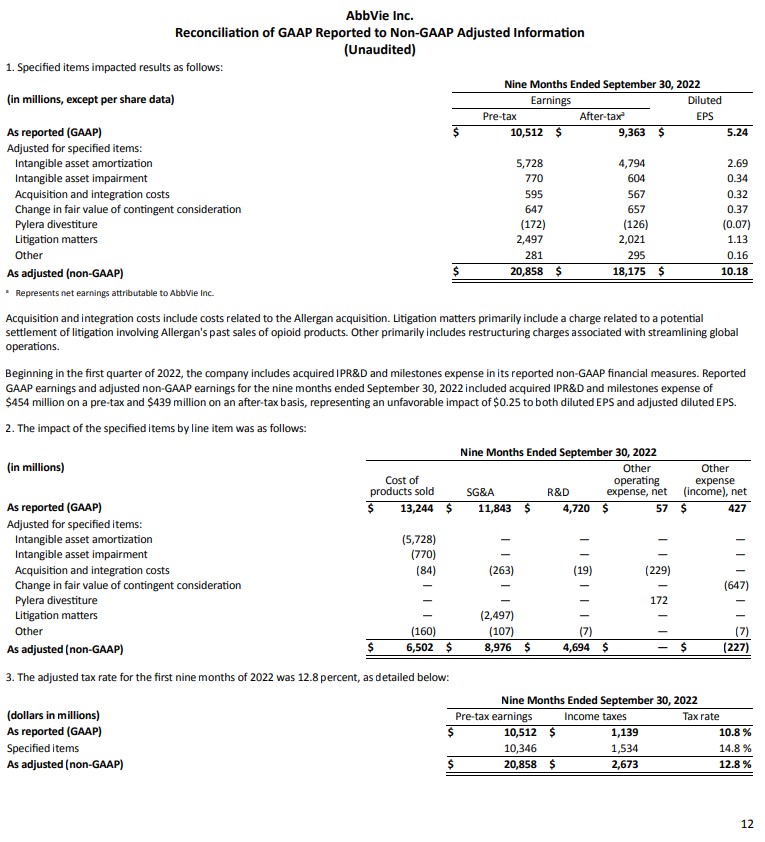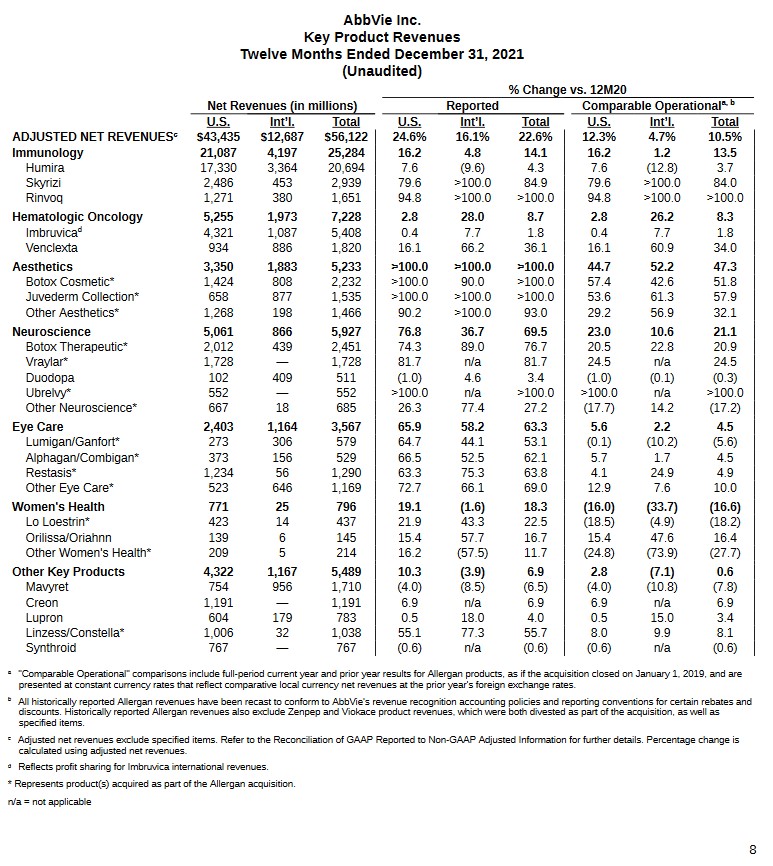Contents

I last reviewed Abbvie Inc. (ABBV) in this February 3, 2022 post, at which time I concluded shares to be overvalued.
At the time of that post, ABBV had just released Q4 and FY2022 results. Given that ABBV issued Q3 and YTD2022 results on October 28, 2022, I take this opportunity to revisit this holding.
Pipeline
In determining whether to invest in a drug manufacturer, I am particularly interested in the company's pipeline and significant programs and developments. On February 2, 2022, ABBV provided a Pipeline Update; the company's pipeline is also accessible here.
Investors need to be keenly aware that Humira (one of ABBV's immunology products) generated ~37% of ABBV's FY2021 Total Revenue and ~36% for the first 9 months in FY2022. Loss of patent protection for this drug expires in 2023 so investors can very likely expect a drop in Humira revenue with the introduction of competing products.
The following reflects the revenue generated from ABBV's portfolio of drugs in Q3 2022 and YTD2022.

Source: ABBV - Q3 2022 Form 10-Q
The following reflects the revenue from ABBV's portfolio of drugs in FY2021.
Before FY2021, ABBV generated no revenue from Skyrizi and Rinvoq, Humira's immunology successors.
Despite the relatively recent introduction of both drugs, Skyrizi and Rinvoq are already having a significant impact on ABBV's growth and performance. In Q3 2022, they contributed ~$2.1B in combined sales, representing ~15% of the total company net revenue.
On the Q3 2022 earnings call, ABBV's Chairman and CEO stated:
- these two new drugs are expected to deliver ~$7.5B in combined sales in FY2022;
- there is a high degree of confidence in Rinvoq's and Skyrizi’s potential to ultimately exceed the peak revenues achieved by Humira; and
- ABBV has achieved total market share leadership in a dozen key international markets, including Japan, Canada and France.
Skyrizi, in particular, continues to exceed management's expectations. Global sales of ~$5.1B are now expected in FY2022 which reflects a $0.3B increase from previous expectations due to strong market share performance.
While Rinvoq has not yet achieved Skyrizi's impressive sales results, it delivered Q3 and YTD2022 global sales of ~$0.695B and ~$1.75B.
Management now expects both drugs to generate significant revenue to fully/partially replace the revenue that will likely be lost when Humira loses its exclusivity in 2023.
Financials
Q3 and YTD2022 Results
Please refer to ABBV's October 28, 2022 Earnings Release and Q3 Form 10-Q for details on results and FY2022 guidance. I, however, provide the following for ease of reference in assessing what line items result in the variance between GAAP and non-GAAP earnings.

Source: ABBV - Q3 2022 Form 8-K
Risk Factor - Concentration of Risk
While the risk associated with the loss of Humira's exclusivity in 2023 is common knowledge, investors would be wise to assess ABBV's other risks. A good source of information regarding various Risk Factors is found in Part 1, Item 1A in the FY2021 Form 10-K.
One particular risk investors must consider is that 3 USA wholesalers (McKesson, Cardinal Health, and AmerisourceBergen) accounted for 79%, 75% and 72% as of September 30, 2022, December 31, 2021 and December 31, 2020 of ABBV's total net accounts receivable. These same 3 wholesalers also accounted for substantially all of ABBV's pharmaceutical product net revenues in the US during these same timeframes.
Given ABBV's heavy dependence on these 3 wholesalers, it is important to gauge their financial strength.
The credit ratings assigned by S&P Global, Moody's, and Fitch are all investment grade. This gives me a reasonable level of confidence they are unlikely to default on their obligations to ABBV in the foreseeable future.

- The A- rating is the bottom tier of the upper medium grade category.
- The BBB and Baa2 ratings are the middle tier of the lower medium grade category.
- The BBB+ rating is the top tier of the lower medium-grade category.
Outlook
In February 2022, ABBV's FY2022 GAAP diluted EPS guidance and adjusted diluted EPS guidance was $9.26 - $9.46 and $14.00 - $14.20, respectively.
ABBV has generated $5.24 in YTD diluted EPS and $10.18 in YTD adjusted diluted EPS. It has also confirmed the midpoint of its FY2022 adjusted diluted EPS guidance range (amended after my prior review) and has narrowed the range from $13.76 - $13.96 to $13.84 - $13.88.
When ABBV released its FY2022 outlook in early February, management's adjusted free cash flow (FCF) outlook was ~$24B. In the first 9 months of FY2022, it has generated ~$17B of free cash flow.
Long-Term Debt
Details of ABBV's long-term debt found on page 74 of 222 in the FY2021 10-K have changed somewhat following FYE2021. Page 18 of 66 in the Q3 2022 Form 10-Q reflects YTD changes in ABBV's debt and credit facilities.
At FYE2021 and FYE2020, ABBV had ~$76.7B and ~$86B of total long-term debt and finance lease obligations with the current portion being ~$12.5B and ~$8.5B and the non-current portion being ~$64.2B and ~$77.6B.
At the end of Q3 2022, the long-term portion was ~$60.4B and the current portion was ~$9.2B.
Investors should not overlook the ~$11.8B of cash and equivalents on ABBV's Balance Sheet at the end of Q3 2022.
On the Q3 earnings call, management reiterated that ABBV remains on track to bring the net leverage ratio to 1.8 times by FYE2022.
Credit Ratings
While ABBV's senior unsecured long-term debt ratings remain unchanged from my prior review, good progress in deleveraging has resulted in favourable changes to ABBV's credit rating outlook from Moody's and S&P Global.
- Moody's: Baa2 with an outlook that was upgraded from stable to positive in March 2022
- S&P Global: BBB+ with an outlook that was upgraded from stable to positive in November 2022
The rating assigned by S&P Global is the top tier of the lower-medium grade investment-grade category and is one tier above Moody's.
Both ratings define ABBV as having an ADEQUATE capacity to meet its financial commitments. However, adverse economic conditions or changing circumstances are more likely to lead to a weakened capacity of the obligor to meet its financial commitments.
These investment-grade ratings are satisfactory for my purposes.
Dividend and Dividend Yield
ABBV's dividend history shows that the quarterly dividend has increased by more than 250% since its inception in 2013.
I purchased 200 shares on October 22, 2021 for ~$108.70/share. Using the previous $1.41/share quarterly dividend, the forward dividend yield was ~5.2%. At the time of my February 3, 2022 post, shares were trading at ~$138.60 and the forward dividend yield was ~4.1%.
On October 27, ABBV declared a $1.48/share quarterly dividend that is payable February 15, 2023 to shareholders of record on January 13, 2023. With shares currently trading at ~$150, the dividend yield is ~3.95%.
While management reiterates its plans to grow the dividend, investors would be wise not to fixate on the dividend or dividend yield. It is preferable to look at a company's total potential investment return (capital gains and dividend income).
The weighted-average diluted shares outstanding (in millions) in FY2013 - FY2021 are 1604, 1610, 1637, 1631, 1603, 1546, 1484, 1673 and 1777. For the 3 months ended September 30, 2022, the weighted-average diluted shares outstanding was 1776.
It repurchased 8 million shares for ~$1.1B during the 9 months ended September 30, 2022 and 5 million shares for ~$0.55B during the 9 months ended September 30, 2021.
The remaining stock repurchase authorization was ~$1.4B as of September 30, 2022.
Valuation
FY2013 - FY2020 PE levels are 18.51, 28.45, 34.64, 16.92, 23.47, 19.13, 39.00, 23.09, and 32.71. As noted in my previous post, however, there is little point in comparing ABBV's current valuation with historical levels because the current version of ABBV is nothing like that before the May 8, 2020 Allergan plc acquisition.
At the time of my October 29, 2021 post, ABBV had generated YTD diluted EPS of $4.19 and FY2021 guidance was $6.29 - $6.33. Using the $6.31 mid-point and the ~$114.70 share price, the forward diluted PE was ~18.
The YTD adjusted diluted EPS at the time of that post was $9.39 and FY2021 guidance was $12.63 - $12.67. Using the $12.65 mid-point, the forward adjusted diluted PE was ~9.
The following forward-adjusted diluted PE levels were derived from the broker guidance reflected on the two online trading platforms I use.
- FY2021 - 19 brokers - mean of $12.60 and low/high of $12.17 - $12.75. Using the mean estimate I get ~9.
- FY2022 - 17 brokers - mean of $13.92 and low/high of $12.87 - $14.70. Using the mean estimate I get ~8.2.
- FY2023 - 14 brokers - mean of $12.17 and low/high of $11.53 - $13.40. Using the mean estimate I get ~9.4.
At the time of my February 3, 2022 post, ABBV had reported $6.45 of FY2021 Diluted EPS on a GAAP basis (a 137.1% YoY increase) and $12.70 of Adjusted Diluted EPS (a 20.3% YoY increase). Its valuation based on historical results is even more favourable than when I wrote my previous post.
As noted earlier, FY2022 GAAP diluted EPS guidance was $9.26 - $9.46 and FY2022 adjusted diluted EPS guidance was $14.00 - $14.20. Using the ~$138.60 share price at the time of that post and the mid-point of guidance, the forward diluted PE was ~14.8 and the forward adjusted diluted PE was ~9.8.
The forward-adjusted diluted PE levels below were based on the broker guidance derived from the two online trading platforms I use.
- FY2022 - 23 brokers - mean of $14.03 and low/high of $13.26 - $14.91. Using the mean estimate I get ~10.
- FY2023 - 20 brokers - mean of $12.11 and low/high of $11.27 - $13.30. Using the mean estimate I get ~11.5.
- FY2024 - 15 brokers - mean of $12.24 and low/high of $11.14 - $13.24. Using the mean estimate I get ~11.3.
Using the current guidance, the following are the forward-adjusted diluted PE levels.
- FY2022 - 15 brokers - mean of $13.87 and low/high of $13.78 - $13.93. Using the mean estimate I get ~10.81.
- FY2023 - 16 brokers - mean of $11.50 and low/high of $10.40 - $12.96. Using the mean estimate I get ~13.
- FY2024 - 15 brokers - mean of $11.39 and low/high of $9.89 - $12.04. Using the mean estimate I get ~13.2.
Final Thoughts
I recognize the outlook for Skyrizi and Rinvoq is promising. However, the impact of Humira's loss of exclusivity is likely to lead to weaker results in FY2023 and FY2024. This is supported by FY2023 and FY2024 adjusted diluted earnings estimates from the brokers which cover ABBV to be much lower than FY2022 estimates. I, therefore, am hesitant to value ABBV based on FY2022 estimates. Looking at ABBV's valuation using FY2023 and FY2024 estimates I view ABBV's valuation to be a bit rich.
Based on current projections, a forward-adjusted diluted PE level closer to 12 seems more reasonable. Using the midpoint of FY2023 earnings estimates from the brokers, a share price below $138 seems more reasonable; ABBV shares were trading around this level as recently as early October.
I envision a broad market pullback within the next few months with ABBV's share price getting caught in any downdraft. This would provide investors with an opportunity to snap up shares at a slightly more favourable valuation.
I wish you much success on your journey to financial freedom!
Note: Thanks for reading this article. Please send any feedback, corrections, or questions to [email protected].
Disclosure: I am long ABBV.
Disclaimer: I do not know your circumstances and am not providing individualized advice or recommendations. I encourage you not to make any investment decisions without conducting your research and due diligence. You should also consult your financial advisor about your specific situation.
I wrote this article myself and it expresses my own opinions. I am not receiving compensation for it and have no business relationship with any company whose stock is mentioned in this article.


